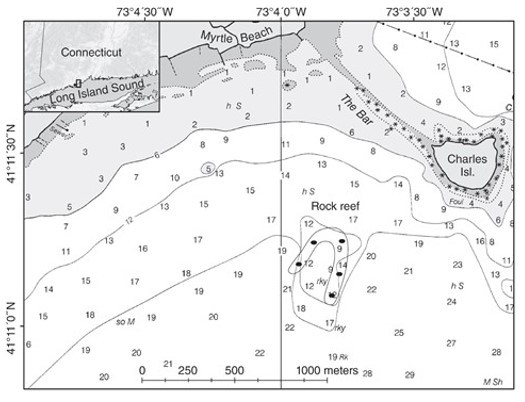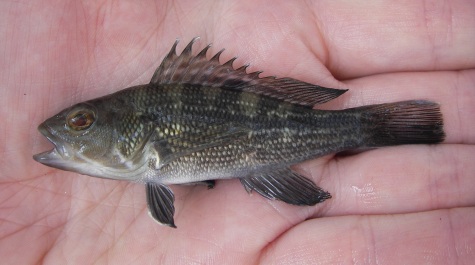Scientists at the Northeast Fisheries Science Center’s Milford Laboratory in Connecticut documented a distinct shift in Long Island Sound fish abundance, with black sea bass showing up in increasing numbers while winter flounder declined.
The findings recently published in Fishery Bulletin are another confirmation of the steady spread northward of black sea bass – now extending into the Gulf of Maine – as waters warm off the Northeast coast.
According to a narrative issued Thursday by the National Marine Fisheries Service, two warm-adapted species: black sea bass, a commercially and recreationally important fish, and oyster toadfish became more abundant in recent samples.
Oyster toadfish prefer rocky habitats and are not often captured by trawl surveys. Meanwhile, cold-adapted species, including cunner and grubby, declined in numbers over the course of the study.
Winter flounder, also a commercial species, and rock gunnel were notably absent in more recent years. Long-term trawl data collected by the Connecticut Department of Energy and Environmental Protection suggests winter flounder abundance has been declining in the Sound for 20 years. The scientists found no consistent trend in the abundance of tautog and scup, two temperate residents of Long Island Sound. The species are often captured on video by our GoPro Aquaculture Project.
Summer water temperatures were a small but statistically significant predictor of changes in species composition. Publicly available long-term temperature records collected at the Milford Laboratory document 50 years of gradually increasing water temperatures in Long Island Sound’s central basin. Both summer and winter temperatures have been on the rise since 1965.
Fish in estuaries like Long Island Sound already experience a broader range of temperatures than fish in the open ocean. Because of this, estuaries are key to monitoring how fish communities are responding to a changing climate. While some species are able to adapt to changing conditions, others may shift northward or become less abundant. Some species may increase in response to warming temperatures.
“This study agrees with what we’ve been seeing throughout southern New England: there’s a definite increase in juvenile black sea bass,” said Gary Shepherd, lead assessment scientist for black sea bass at the Northeast Fisheries Science Center. “The fish caught in 2016 were likely from the 2015 spawning, when there was good survival of the young sea bass because of favorable oceanographic conditions offshore during the winter.”
The Milford Lab’s GoPro Aquaculture Project uses cameras to collect video at a rock reef and around oyster aquaculture gear. It continues to document high abundance of black sea bass, including young-of-the-year and juvenile fish.
Fish traps are helpful to sample areas like rock reefs where an uneven seafloor makes trawling challenging or impossible. These samples paint a more complete picture of fish abundance.
The team from the Milford Lab used fish traps with a mesh size that targets juvenile and small adult fish living close to the seafloor. They placed traps in a temperate rock reef habitat west of Charles Island in Milford, Conn., during six summers between 2004 and 2016. The research team deployed strings of traps for 24 hours, two to three times per week at five sites. Because the number of sampling trips and traps deployed varied from year to year, the team used catch-per-unit-effort as a standardized index of abundance. This allowed them to compare data collected among years. Scientists released the fish after sampling.
Reef fish are structure-oriented, meaning they rely on rock reefs and other structures for shelter and camouflage to avoid predators. Rock reefs are particularly important in the central basin of Long Island Sound, where most of the seafloor is flat and composed of sand and shell. Fish also eat the algae and invertebrates growing on the reef. They typically return to the same reefs year after year.

Many of the species studied, including grubby and cunner, are not regularly harvested. This makes it more likely that their declining abundance is related to environmental change rather than fishing. Millstone Power Station in Waterford, Conn., also documented a decline in grubby.
The Connecticut environmental department and power station staff conducted trawl surveys during this time period. Both datasets corroborate the striking increase in black sea bass across Long Island Sound.
The state agency has conducted annual spring and fall trawl surveys across a broad swath of Long Island Sound since 1984.
“Around 2010-2012, we started to see a spike in the black sea bass population; we were actually able to track that strong year class for the next several years,” said state fisheries biologist Dave Ellis. “Historically, it was normal to see warm water species in the Sound in summer and early fall, but now these fish aren’t coming and going; they’re year-round residents.”
Ellis also noted that prior to the last decade, anglers often had to venture outside of the Sound to find black sea bass. Now they don’t have to go far to catch them; they are quickly becoming one of the most popular recreational fish in the area.
The Millstone Power Station conducted a bottom trawl survey at multiple stations near Niantic Bay in eastern Long Island Sound since 1976 to assess bottom-dwelling fishes and invertebrates.
“We’re seeing cool-water species, including winter spawners such as grubby and winter flounder, become less abundant, and warm-water species like black sea bass that have historically been more predominant in the mid-Atlantic waters, similar to the Chesapeake Bay region, become more abundant,” said Millstone biologist Steve Dwyer. “These findings are consistent with other surveys in southern New England. There’s value in talking with other scientists in real-time to compare data about what we’re seeing.”
Paul Clark, a NOAA Fisheries biologist and co-author of the study, also investigated what the increasingly abundant black sea bass are eating.
“They tend to be opportunistic feeders,” said Clark. “I’ve analyzed their stomach contents. In addition to smaller black sea bass, they’ve been eating cunner, rock gunnel, young tautog, crabs, shrimp, and more.”
In addition to temperature, predation by black sea bass may be contributing to the shift in fish communities.
The study finds that seemingly subtle temperature increases over time may have contributed to changes in composition and abundance of fish species on a rock reef in Long Island Sound. Several research groups monitoring different parts of Long Island Sound have simultaneously documented the increasing abundance of black sea bass.
This likely signals a northward expansion as the warming Sound becomes a more hospitable habitat.







